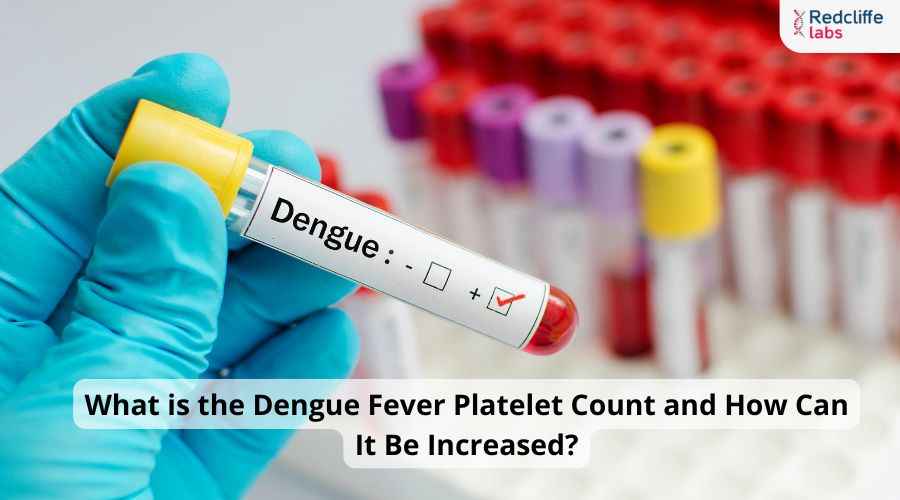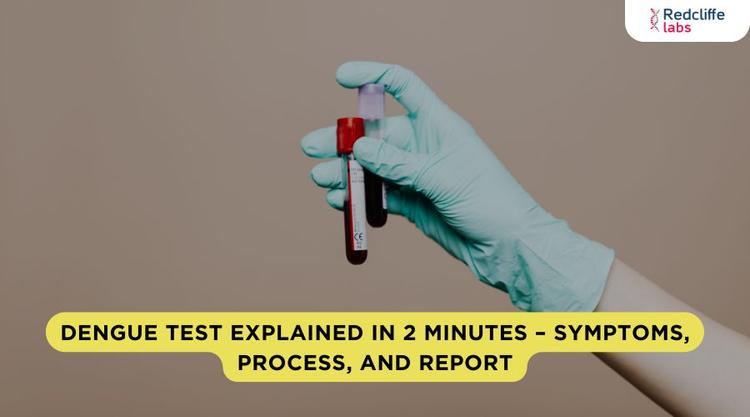What is the Dengue Fever Platelet Count and How Can It Be Increased?

Medically Reviewed By
Prof. Ashok Rattan
Written By Muskan Taneja
on Feb 17, 2025
Last Edit Made By Muskan Taneja
on Jul 19, 2025

Did you know a normal platelet count in a healthy adult is between 150,000 and 450,000 platelets per microliter of blood? During dengue fever, the platelet count drops significantly, leading to a condition called ‘thrombocytopenia’ or low platelet count.
But why does platelet count decrease in dengue? Let’s find out.
What is Dengue?
Dengue is a mosquito-borne viral infection caused by the dengue virus (DENV), which belongs to the flavivirus family. It is transmitted to humans through the bite of infected Aedes mosquitoes, primarily Aedes aegypti and Aedes albopictus.
The platelet count usually recovers within 1-2 weeks after dengue fever. However, in some cases, persistent symptoms may include bleeding gums, restlessness, blood in vomit, and pale skin.
Did You Know?
In 2024, there were 1,86,567 cases of dengue fever in India, and states like Uttar Pradesh, West Bengal, Bihar, Karnataka, and Rajasthan experienced a major outbreak.
10 Symptoms of Dengue
Dengue fever causes flu-like symptoms. These include:
- High fever
- Severe headache
- Pain behind the eyes
- Muscle and joint pain
- Loss of appetite
- Skin rashes
- Nausea
- Vomiting
- Cough
- Sore throat
Want to understand dengue symptoms in detail? Check out Dengue Fever Symptoms.
Dengue and Platelet Count
Platelets are small and colorless cell fragments in the blood that play a crucial role in hemostasis. A significant drop in platelet count indicates the severity of the disease. These minute cells are vital in blood clotting to stop bleeding.
Role of Platelets in Dengue Fever
- Platelets are the first responders to dengue fever. They adhere to the exposed collagen fibers of the vessel wall, forming a platelet plug. This plug is important for preventing further blood loss.
- Platelets release many chemicals that enhance the clotting process. These chemicals include serotonin, thromboxane A2, and ADP.
- Platelets initiate the coagulation cascade, providing a surface for clotting factors assembly. These proteins in the blood plasma work together to form a stable blood clot.
- Platelets contain Transforming Growth Factor-beta (TGF-β) and Platelet-Derived Growth Factor (PDGF), released at the injury site. They play a crucial role in tissue repair and wound healing.
What’s the Normal vs Abnormal Dengue Fever Platelet Count?
A low platelet count shows signs of an increase in bleeding. It can occur through nose bleeding, gum bleeding, internal bleeding, or bruises. In addition, it is important to understand the difference between normal and abnormal platelet counts.
- Normal Platelet Count- The normal platelet count is between 150,000 to 450,000 platelets per microliter of blood.
- Abnormal Platelet Count—The dengue virus can cause the platelet count to drop significantly, ranging from a mild decrease to a severe drop. It can fall below 100,000 platelets per microliter of blood.
Why Do Platelets Drop in Dengue?
Dengue fever disrupts normal platelet production and triggers events that lead to their destruction. Let’s understand in brief.
- Increased Platelet Destruction
The dengue infection throws the immune system into overdrive. Sometimes, in its fight against the virus, the immune system mistakenly identifies healthy platelets as invaders and destroys them, further contributing to the drop in the dengue fever platelet count.
- Disrupted Platelet Production
The dengue virus can infiltrate the bone marrow, the factory where platelets are produced. This infiltration disrupts the normal production process, releasing a few platelets into the bloodstream.
14 Symptoms of Low Platelets in Dengue
If you have a low platelet count, you may experience:
- Bleeding from the nose, gums, or other part of the body.
- Easy bruising
- Small purple spots
- Large reddish-brown patches
- Severe abdominal pain
- Blood in vomit
- Black stools
- Blood in urine
- Weakness or tiredness
- Light-headedness
- Fever
- Muscle and Joint pain
- Skin rash
- Lack of appetite
What is the Minimum Platelet Count for Dengue?
A platelet count below 50,000 per microliter is severely low in dengue fever. However, the minimum drop is 10,000 per microliter or even lower.
| Count (per microliter) | What Does it Mean? |
| 150,000 - 450,000 | Normal platelet count |
| 100,000 - 150,000 | Slightly low, usually not concerning, but should be monitored. |
| 50,000 - 100,000 | Moderate decrease in risk of bleeding with injury. |
| 30,000 - 50,000 | Increased risk of bleeding; caution needed |
| 10,000 - 30,000 | High risk of spontaneous bleeding; medical attention required |
| Below 10,000 | Critical risk; immediate medical intervention and transfusion needed |
What you should do: If you experience symptoms of low platelet count, consult a physician. They may prescribe a blood test to check your platelet count. Early detection can help manage dengue conditions and reduce the risk of major problems.
What’s the Day By Day Platelet Count in Dengue Fever?
The platelet count is below 50,000 platelets per microliter. However, the platelet count in dengue fever changes day by day.
- Day 1- Platelet count is typically high.
- Day 3- Platelet counts start to decrease.
- Day 5- Platelet count reaches its lowest points.
- Day 7- Platelet counts start to improve.
- Day 8-9- Platelet counts return to normal.
When will the platelet count increase for dengue fever?
Are you concerned about when your platelet count will return to normal? Don’t worry; we’ve got you covered.
Platelet count in dengue fever usually increases 3-4 days after the fever subsides. They typically return to normal within 7-10 days. However, the recovery time depends on your health and the severity of the infection.
For a speedy recovery, make dietary changes and avoid alcoholic and caffeinated beverages.
How to Increase Platelet Count in Dengue?
A dengue fever diet can help increase the platelet count. However, some natural ways to increase platelet count in dengue fever exist.
Natural Ways
- Giloy
- Pomegranate
- Pumpkin
- Aloe Vera
- Papaya Leaf Extract
- Spinach
- Wheatgrass
- Beetroot and Carrot Juice
Also, read https://redcliffelabs.com/myhealth/lifestyle/15-effective-home-remedies-for-dengue/
Medical Treatment
A healthcare professional may also prescribe medications and platelet transfusions in severe cases.
- Intravenous Fluids—IV fluids can maintain blood pressure and hydration, crucial for managing dengue fever. Proper hydration is also important for platelet function and improving overall health.
- Platelet Transfusions—The transfusion involves transferring platelets from a donor to a patient to prevent bleeding complications. It is normally suggested for patients with very critical cases.
- Monitoring and Supportive Care—Regular monitoring of platelet counts and planning pain management and fever control strategies can help manage dengue fever overall.
Dietary Modifications
- Add foods rich in vitamin C to your diet. Vitamin C can help absorb iron and support the overall immune system. Fresh fruits such as oranges, lemons, and grapefruits are added to your diet.
- Protein-rich Foods- Protein-rich foods such as lean meats, fish, eggs, and legumes are essential for cell repair and regeneration.
- Folic Acid-rich Foods- These foods include lentils, beans, and green leafy vegetables, which are important for producing healthy blood cells.
- Zinc-rich Foods—Nuts, seeds, and whole grains are essential zinc-rich foods that can help cell growth and support the immune system.
Hydration and Fluid Management
Hydration is essential for dengue recovery and can also help increase platelet count. Drink fluids like water and coconut water, and avoid caffeinated beverages and sugary drinks, as they may dehydrate you.
The Bottom Line
Platelets play a crucial role in dengue fever. They are the first to encounter the infection, so platelet count decreases during the illness. The best part? The level gradually increases at the end of the period. However, you can also opt for natural remedies, dietary modifications, and certain medications to increase the platelet count in dengue fever.
If you see symptoms of dengue, such as fever, joint pain, and skin rash, then book a Dengue NS1 Antigen Test by ELISA from Redcliffe Labs at an affordable price and with a home sample collection service. Follow the steps below to book a test from Redcliffe Labs.
Get Tested for Dengue in the Comfort of Your Home.
- Visit www.redcliffelabs.com
- Search for the test you need.
- Fill out the required details: name, address, preferred time, and contact information.
- Make the payment.
- A phlebotomist will visit your home for sample collection.
Note: You will receive a confirmation through SMS or WhatsApp.
FAQs
Ques1 When will the platelet count increase in dengue?
Ans1 The platelet count usually increases within 3 to 4 days after the fever subsides. They typically return to normal within 7-10 days. However, the recovery time can depend on the severity of the dengue fever.
Ques2 What is the minimum platelet count for dengue?
Ans2 A normal platelet count is between 150,000 and 450,000 per microliter. However, the platelet count for dengue fever is below 50,000 per microliter. The platelet count may drop to 10,000 per microliter in some people.
Ques3 Is a 50,000 platelet count dangerous in dengue?
Ans3 A platelet count below 50,000 is considered dangerous in dengue. It can indicate the risk of bleeding. Depending on the severity, a healthcare provider may recommend medical monitoring and treatments like platelet transfusion.



